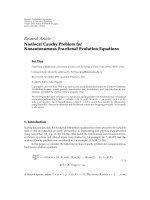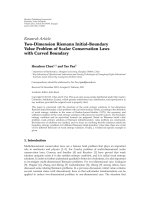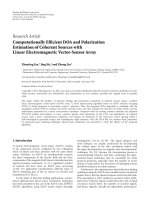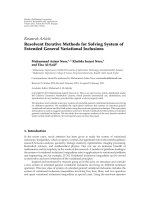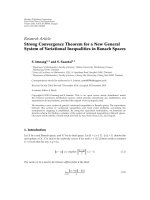Báo cáo hóa học: " Research Article Implicit Iteration Process for Common Fixed Points of Strictly Asymptotically Pseudocontractive Mappings in Banach Spaces" doc
Bạn đang xem bản rút gọn của tài liệu. Xem và tải ngay bản đầy đủ của tài liệu tại đây (502.83 KB, 12 trang )
Hindawi Publishing Corporation
Fixed Point Theory and Applications
Volume 2008, Article ID 324575, 12 pages
doi:10.1155/2008/324575
Research Article
Implicit Iteration Process for Common Fixed
Points of Strictly Asymptotically Pseudocontractive
Mappings in Banach Spaces
You Xian Tian,
1
Shih-sen Chang,
2
Jialin Huang,
2
Xiongrui Wang,
2
andJ.K.Kim
3
1
College of Mathematics and Physics, Chongqing University of Post Telecommunications,
Chongqing 400065, China
2
Department of Mathematics, Yibin University, Yibin, Sichuan 644007, China
3
Department of Mathematics, Kyungnam University, Masan 631-701, South Korea
Correspondence should be addressed to You Xian Tian,
Received 25 May 2008; Accepted 3 September 2008
Recommended by Nanjing Huang
In this paper, a new implicit iteration process with errors for finite families of strictly asymptot-
ically pseudocontractive mappings and nonexpansive mappings is introduced. By using the
iterative process, some strong convergence theorems to approximating a common fixed point of
strictly asymptotically pseudocontractive mappings and nonexpansive mappings are proved. The
results presented in the paper are new which extend and improve some recent results of Osilike
et al. 2007,Liu1996, Osilike 2004,SuandLi2006,Gu2007,XuandOri2001.
Copyright q 2008 You Xian Tian et al. This is an open access article distributed under the Creative
Commons Attribution License, which permits unrestricted use, distribution, and reproduction in
any medium, provided the original work is properly cited.
1. Introduction and preliminaries
Throughout this paper, we assume that E is a real Banach space, C is a nonempty closed
convex subset of E, E
∗
is the dual space of E,andJ : E → E
∗
is the normalized duality mapping
defined by
Jx
f ∈ E
∗
: x, f ||x||
2
||f||
2
,x∈ E. 1.1
Recall that a set C ⊂ E is said to be closed, convex, and pointed cone if it is a closed set
and satisfies the following conditions: 1 C C ⊂ C; 2 λC ⊂ C for each λ ≥ 0; 3 if x ∈ C
with x
/
0, then −x
/
∈ C.
2 Fixed Point Theory and Applications
Definition 1.1. Let T : C → C be a mapping:
1 T is said to be λ, {k
n
}-strictly asymptotically pseudocontractive if there exist a
constant λ ∈ 0, 1 and a sequence {k
n
}⊂1, ∞ with k
n
→ 1 such that for all
x, y ∈ C,andforalljx − y ∈ Jx − y,
T
n
x − T
n
y, jx − y
≤ k
n
||x − y||
2
− λ
x − T
n
x −
y − T
n
y
2
∀n ≥ 1, 1.2
2 T is said to be λ-strictly pseudocontractive in the terminology of Browder-Petryshyn 1
if there exist a constant λ ∈ 0, 1 such that for all x, y ∈ C,
Tx − Ty, jx − y
≤||x − y||
2
− λ
x − Tx − y − Ty
2
∀jx − y ∈ Jx − y, 1.3
3 T is said to be uniformly L-Lipschitzian if there exists a constant L>0 such that
T
n
x − T
n
y
≤ L||x − y|| ∀n ≥ 1. 1.4
The class of λ, {k
n
}-strictly asymptotically pseudocontractive mappings was first
introduced in Hilbert spaces by Liu 2. In the case of Hilbert spaces, it is shown by 2 that
1.2 is equivalent to the inequality
T
n
x − T
n
y
2
≤ k
n
||x − y||
2
λ
I − T
n
x −
I − T
n
y
2
. 1.5
Concerning the convergence problem of iterative sequences for strictly pseudocontrac-
tive mappings has been studied by several authors see, e.g., 1, 3–7. Concerning the class
of strictly asymptotically pseudocontractive mappings, Liu 2 and Osilike et al. 8 proved
the following results.
Theorem 1.2 Liu 2. Let H be a real Hilbert space, let C be a nonempty closed convex and bounded
subset of H, and let T : C → C be a completely continuous uniformly L-Lipschitzian λ, {k
n
}-strictly
asymptotically pseudocontractive mapping such that
∞
n1
k
2
n
− 1 < ∞.Let{α
n
}⊂0, 1 be a
sequence satisfying the following condition:
0 <≤ α
n
≤ 1 − λ − ∀n ≥ 1 and some >0. 1.6
Then, the sequence {x
n
} generated from an arbitrary x
1
∈ C by
x
n1
1 − α
n
x
n
α
n
T
n
x
n
∀n ≥ 1 1.7
converges strongly to a fixed point of T.
In 2007, Oslike et al. 8 proved the following theorem.
You Xian Tian et al. 3
Theorem 1.3 Oslike et al. 8. Let E be a real q-uniformly smooth Banach space which is also
uniformly convex, let C be a nonempty closed convex subset of E,letT : C → C be a λ, {k
n
}-
strictly asymptotically pseudocontractive mapping such that
∞
n1
k
n
− 1 < ∞, and let FT
/
∅.
Let {α
n
}⊂0, 1 be a real sequence satisfying the following condition:
0 <a≤ α
q−1
n
≤ b<
q1 − k
2c
q
1 L
−q−2
∀n ≥ 1. 1.8
Let {x
n
} be the sequence defined by 1.7. Then,
1 lim
n →∞
||x
n
− p|| exists ∀ p ∈ FT,
2 lim
n →∞
||x
n
− Tx
n
|| 0,
3 {x
n
} converges weakly to a fixed point of T.
It is our purpose in this paper to introduce the following new implicit iterative process
with errors for a finite family of strictly asymptotically pseudocontractive mappings {T
i
} and
a finite family of nonexpansive mappings {S
i
}:
x
1
∈ C,
x
n
α
n
S
n
x
n−1
1 − α
n
T
n
n
x
n
u
n
∀n ≥ 1,
1.9
where C is a closed convex cone of E, S
n
S
nmod N
, T
n
n
T
n
nmod N
,and{u
n
} is a bounded
sequence in C. Also, we aim to prove some strong convergence theorems to approximating
a common fixed point of {S
i
} and {T
i
}. The results presented in the paper are new which
extend and improve some recent results of 2–8.
In order to prove our main results, we need the following lemmas.
Lemma 1.4 see 9. Let E be a real Banach space, let C be a nonempty subset of E, and let T : C → C
be a λ, {k
n
}-strictly asymptotically pseudocontractive mapping, then T is uniformly L-Lipschitzian.
Lemma 1.5. Let E be a real Banach space, let C be a nonempty closed convex subset of E, and let
T
i
: C → C be a λ
i
, {k
i
n
}-strictly asymptotically pseudocontractive mapping, i 1, 2, ,N,then
there exist a constant λ ∈ 0, 1, a constant L>0, and a sequence {k
n
}⊂1, ∞ with lim
n →∞
k
n
1
such that for any x, y ∈ C and for each i 1, 2, ,N and each n ≥ 1, the following hold:
T
n
i
x − T
n
i
y, jx − y
≤ k
n
||x − y||
2
− λ
x − T
n
i
x −
y − T
n
i
y
2
1.10
for each jx − y ∈ Jx − y and
T
n
i
x − T
n
i
y
≤ L||x − y||. 1.11
Proof. Since for e ach i 1, 2, ,N, T
i
is λ
i
, {k
i
n
}-strictly asymptotically pseudocontractive,
where λ
i
∈ 0, 1 and {k
i
n
}⊂1, ∞ with lim
n →∞
k
i
n
1. By Lemma 1.4, T
i
is L
i
-Lipschitzian.
4 Fixed Point Theory and Applications
Taking k
n
max{k
i
n
,i 1, 2, ,N} and λ min{λ
i
,i 1, 2, ,N}, hence, for each i
1, 2, ,N, we have
T
n
i
x − T
n
i
y, jx − y
≤ k
i
n
||x − y||
2
− λ
i
x − T
n
i
x −
y − T
n
i
y
2
≤ k
n
||x − y||
2
− λ
x − T
n
i
x −
y − T
n
i
y
2
.
1.12
The conclusion 1.10 is proved. Again, taking L max{L
i
: i 1, 2, N} for any x, y ∈ C,
we have
T
n
i
x − T
n
i
y
≤ L
i
||x − y|| ≤ L||x − y|| ∀n ≥ 1. 1.13
This completes the proof of Lemma 1.5.
Lemma 1.6 see 9. Let {a
n
}, {b
n
}, and {c
n
} be three nonnegative real sequences satisfying the
following condition:
a
n1
≤
1 b
n
a
n
c
n
∀n ≥ n
0
, 1.14
where n
0
is some nonnegative integer such that
∞
n1
b
n
< ∞ and
∞
n1
c
n
< ∞,thenlim
n →∞
a
n
exists.
In addition, if there exists a subsequence {a
n
i
}⊂{a
n
} such that a
n
i
→ 0,thena
n
→
0 n →∞.
2. Main results
We are now in a position to prove our main results in this paper.
Theorem 2.1. Let E be a real Banach space, let C be a nonempty closed pointed convex cone of E,let
T
i
: C → C, i 1, 2, ,N, be a finite family of λ
i
, {k
i
n
}-strictly asymptotically pseudocontractive
mappings, and let S
i
: C → C, i 1, 2, ,N,be a finite family of nonexpansive mappings with
F
N
i1
F
S
i
N
i1
F
T
i
/
∅ 2.1
(the set of common fixed points of {S
i
} and {T
i
}). Let {α
n
} be a sequence in 0, 1,let{u
n
} be a
bounded sequence in C,letλ min{λ
i
: i 1, 2, ,N}, k
n
max{k
i
n
,i 1, 2, ,N}, and let
L max {L
i
: i 1, 2, ,N} > 0 be positive numbers defined by 1.10 and 1.11, respectively. If
the following conditions are s atisfied:
i 0 < max{λ, 1 − 1/L} < lim inf
n →∞
α
n
≤ α
n
< 1,
ii
∞
n1
1 − α
n
∞,
iii
∞
n1
k
n
− 1 < ∞ and 1 ≤ k
n
< 1 − λ/1 − lim inf
n →∞
α
n
,
iv
∞
n1
||u
n
|| < ∞,
You Xian Tian et al. 5
then the iterative sequence {x
n
} with errors defined by 1.9 has the following properties:
1 lim
n →∞
||x
n
− p|| exists for each p ∈ F,
2 lim
n →∞
dx
n
,F exists,
3 lim inf
n →∞
||x
n
− T
n
n
x
n
|| 0,
4 the sequence {x
n
} converges strongly to a common fixed point p ∈ F if and only if
lim inf
n →∞
d
x
n
,F
0. 2.2
Proof. We divide the proof of Theorem 2.1 into four steps.
I First, we prove that the mapping G
n
: C → C, n 1, 2, ,defined by
G
n
xα
n
S
n
x
n−1
1 − α
n
T
n
n
x u
n
,x∈ C 2.3
is a Banach contractive mapping.
Indeed, it follows from condition i that 1 − 1/L<α
n
,thatis,1 − α
n
L<1. Hence,
from Lemma 1.5, for any x, y ∈ C, we have
G
n
x − G
n
y
α
n
S
n
x
n−1
1 − α
n
T
n
n
x u
n
−
α
n
S
n
x
n−1
1 − α
n
T
n
n
y u
n
1 − α
n
T
n
n
x − T
n
n
y
≤ 1 − α
n
L||x − y||,n 1, 2, ,
2.4
that is, for each n 1, 2, , G
n
: C → C is a Banach contraction mapping. Therefore, there
exists a unique fixed point x
n
∈ C such that x
n
Gx
n
. This shows that the sequence {x
n
}
defined by 1.9 is well defined.
II The proof of conclusions 1 and 2.
For any given p ∈ F and for any jx
n
− p ∈ Jx
n
− y from Lemma 1.5, we have
x
n
− p
2
α
n
S
n
x
n−1
− p
1 − α
n
T
n
n
x
n
− p
u
n
2
α
n
S
n
x
n−1
− p, j
x
n
− p
1 − α
n
T
n
n
x
n
− p, j
x
n
− p
u
n
,j
x
n
− p
≤ α
n
x
n−1
− p
x
n
− p
1 − α
n
k
n
x
n
− p
2
− λ
x
n
− T
n
n
x
n
2
u
n
x
n
− p
.
2.5
Simplifying it, we have
x
n
− p
≤
α
n
1 −
1 − α
n
k
n
x
n−1
− p
u
n
1 −
1 − α
n
k
n
−
1 − α
n
λ
1 −
1 − α
n
k
n
·
x
n
− T
n
n
x
n
2
x
n
− p
.
2.6
By virtue of conditions i and iii, we have
k
n
≤
1 − λ
1 − lim inf
n →∞
α
n
≤
1 − λ
1 − α
n
, 2.7
6 Fixed Point Theory and Applications
and so
0 <λ≤ 1 −
1 − α
n
k
n
< 1. 2.8
It follows from 2.6 and 2.8 that
x
n
− p
≤
α
n
1 −
1 − α
n
k
n
x
n−1
− p
u
n
λ
−
1 − α
n
λ ·
x
n
− T
n
n
x
n
2
x
n
− p
1
1 − α
n
k
n
− 1
1 −
1 − α
n
k
n
x
n−1
− p
u
n
λ
−
1 − α
n
λ ·
x
n
− T
n
n
x
n
2
x
n
− p
.
2.9
Letting b
n
1 − α
n
k
n
− 1/1 − 1 − α
n
k
n
and c
n
u
n
/λ, then we have
x
n
− p
≤
1 b
n
x
n−1
− p
c
n
∀n ≥ 1. 2.10
By using 2.8,
b
n
≤
1 − α
n
k
n
− 1
λ
<
k
n
− 1
λ
. 2.11
By conditions iii and iv,
∞
n1
b
n
< ∞ and
∞
n1
c
n
< ∞.ByvirtueofLemma 1.6,
lim
n →∞
||x
n
− p|| exists; and so {x
n
} is a bounded sequence in C. Denote
M sup
n≥1
x
n
− p
. 2.12
From 2.10, we have
d
x
n
,F
≤
1 b
n
d
x
n−1
,F
c
n
∀n ≥ 1. 2.13
By using Lemma 1.6 again, we know that lim
n →∞
dx
n
,F exists.
The conclusions 1 and 2 are proved.
III The proof of conclusion 3.
It follows from 2.9 that
x
n
− p
≤
1 b
n
x
n−1
− p c
n
−
1 − α
n
λ ·
x
n
− T
n
n
x
n
2
M
≤
x
n−1
− p
b
n
M c
n
−
1 − α
n
λ ·
x
n
− T
n
n
x
n
2
M
,
2.14
that is,
1 − α
n
λ ·
x
n
− T
n
n
x
n
2
M
≤
x
n−1
− p
−
x
n
− p
b
n
M c
n
. 2.15
You Xian Tian et al. 7
For any positive number n
1
, we have
λ
M
n
1
n1
1 − α
n
x
n
− T
n
n
x
n
2
≤
x
0
− p
−
x
n
1
− p
n
1
n1
b
n
M c
n
≤
x
0
− p
n
1
n1
b
n
M c
n
.
2.16
Letting n
1
→∞, we h ave
λ
M
∞
n1
1 − α
n
x
n
− T
n
n
x
n
2
≤
x
0
− p
∞
n1
b
n
M c
n
< ∞. 2.17
By condition ii, we have
lim inf
n →∞
x
n
− T
n
n
x
n
0. 2.18
IV Next, we prove the conclusion 4.
Necessity
If {x
n
} converges strongly to some point p ∈ F, then from 0 ≤ dx
n
,F ≤x
n
− p→0, we
have
lim inf
n →∞
d
x
n
,F
0. 2.19
Sufficiency
If lim inf
n →∞
dx
n
,F0, it follows from the conclusion 2 that lim
n →∞
dx
n
,F0.
Next, we prove that {x
n
} is a Cauchy sequence in C. In fact, since for any t>0, 1 t ≤
expt, therefore, for any m, n ≥ 1 and for given p ∈ F,from2.10, we have
x
nm
− p
≤
1 b
nm
x
nm−1
− p
c
nm
≤ exp
b
nm
x
nm−1
− p
c
nm
≤ exp
b
nm
exp
b
nm−1
x
nm−2
− p
c
nm−1
c
nm
exp
b
nm
b
nm−1
}
x
nm−2
− p
exp
b
nm
c
nm−1
c
nm
≤···
≤ exp
nm
in1
b
i
x
n
− p
nm
in1
exp
nm
ji1
b
j
c
i
≤ K
x
n
− p
nm
in1
c
i
< ∞,
2.20
8 Fixed Point Theory and Applications
where K exp{
∞
j1
b
j
} < ∞. Since
lim
n →∞
d
x
n
,F
0,
∞
n1
c
n
< ∞ 2.21
for any given >0, there exists a positive integer n
1
such that
d
x
n
,F
<
4K 1
,
∞
in1
c
i
<
2K
∀n ≥ n
1
. 2.22
Hence, there exists p
1
∈ F such that
x
n
− p
1
<
2K 1
∀n ≥ n
1
. 2.23
Consequently, for any n ≥ n
1
and m ≥ 1, from 2.20, we have
x
nm
− x
n
≤
x
nm
− p
1
x
n
− p
1
≤ K
x
n
− p
1
nm
in1
c
i
x
n
− p
1
≤ K 1
x
n
− p
1
K
nm
in1
c
i
≤ K 1
2K 1
K
2K
.
2.24
This implies that {x
n
} is a Cauchy sequence in C.Letx
n
→ x
∗
∈ C. Since lim
n →∞
dx
n
,F0,
and so dx
∗
,F0. Again, since {S
n
} is a finite family of nonexpansive mappings and {T
n
}
is a finite family of strictly asymptotically pseudocontractive mappings, by Lemma 1.5,itis
a finite family of uniformly Lipschitzian mappings. Hence, the set F of common fixed points
of {S
n
} and {T
n
} is closed and so x
∗
∈ F.
This completes the proof of Theorem 2.1.
Remark 2.2. Theorem 2.1 is a generalization and improvement of the corresponding results in
Osilike et al. 8 and Liu 2 which is also an improvement of the corresponding results in
3, 5–7.
The following theorem can be obtained from Theorem 2.1 immediately.
Theorem 2.3. Let E be a real Banach space, let C be a nonempty closed pointed convex cone of E,let
T : C → C be a λ, {k
n
}-strictly asymptotically pseudocontractive mappings, and let {S
i
: C → C, i
1, 2, ,N} be a finite family of nonexpansive mappings with
F
N
i1
F
S
i
FT
/
∅ 2.25
You Xian Tian et al. 9
(the set of common fixed points of {S
i
} and T). Let {α
n
} be a sequence in 0, 1,let{u
n
} be a bounded
sequence in C. If the following conditions are satisfied:
i 0 < max{λ, 1 − 1/L} < lim inf
n →∞
α
n
≤ α
n
< 1, where L>0 is a constant appeared in
Lemma 1.4,
ii
∞
n1
1 − α
n
∞,
iii
∞
n1
k
n
− 1 < ∞ and 1 ≤ k
n
< 1 − λ/1 − lim inf
n →∞
α
n
,
iv
∞
n1
||u
n
|| < ∞,
then the conclusions in Theorem 2.1 still hold.
Theorem 2.4. Let E be a real Banach space, let C be a nonempty closed convex subset of E, and
{T
i
: C → C, i 1, 2, ,N} be a finite family of λ
i
, {k
i
n
}-strictly asymptotically pseudocontractive
mappings, and let {S
i
: C → C, i 1, 2, ,N} be a finite family of nonexpansive mappings with
F
N
i1
F
S
i
N
i1
FT
i
/
∅ 2.26
(the set of common fixed points of {S
i
} and {T
i
}). Let {x
n
} be the sequence defined by the following:
for any given x
1
∈ C,
x
n
α
n
S
n
x
n−1
β
n
T
n
n
x
n
γ
n
u
n
∀n ≥ 1, 2.27
where S
n
S
nmod N
, T
n
n
T
n
nmod N
, {α
n
}, {β
n
}, and {γ
n
} are sequences in 0, 1 with α
n
β
n
γ
n
1, {u
n
} is a bounded sequence in C, λ min{λ
i
: i 1, 2, ,N}, k
n
max{k
i
n
,i
1, 2, ,N}, and L max{L
i
: i 1, 2, ,N} > 0 are positive numbers defined by 1.10 and
1.11, respectively. If the following conditions are satisfied:
i 0 <λ<lim inf
n →∞
α
n
≤ α
n
< 1,
ii
∞
n1
1 − α
n
∞,
iii 0 <β
n
≤ lim sup
n →∞
β
n
≤ min{1 − λ, 1/L} < 1,
iv
∞
n1
k
n
− 1 < ∞ and 1 ≤ k
n
< 1 − λ/1 − lim inf
n →∞
α
n
,
v
∞
n1
γ
n
< ∞,
then the conclusions of Theorem 2.1 for sequence {x
n
} defined by 2.27 still hold.
Proof. By the same method as given in the proof of Theorem 2.1, we can prove that the
mapping W
n
: C → C defined by
W
n
xα
n
S
n
x
n−1
β
n
T
n
n
x γ
n
u
n
,x∈ C, n ≥ 1, 2.28
is a Banach contractive mapping. Hence, there exists a unique x
n
∈ C such that x
n
Wx
n
.
This implies that the sequence {x
n
} defined by 2.27 is well defined.
10 Fixed Point Theory and Applications
For each p ∈ F, we have
x
n
− p
2
α
n
S
n
x
n−1
− p, j
x
n
− p
β
n
T
n
n
x
n
− p, j
x
n
− p
γ
n
u
n
− p, j
x
n
− p
≤ α
n
x
n−1
− p
x
n
− p
β
n
k
n
x
n
− p
2
− λ
x
n
− T
n
n
x
n
2
γ
n
u
n
− p
x
n
− p
.
2.29
Simplifying it, we have
x
n
− p
2
≤
α
n
x
n−1
− p
x
n
− p
1 − β
n
k
n
−
β
n
λ
1 − β
n
k
n
x
n
− T
n
n
x
n
2
γ
n
1 − β
n
k
n
u
n
− p
x
n
− p
.
2.30
Since
lim sup
n →∞
β
n
lim sup
n →∞
1 − α
n
− γ
n
≤ lim sup
n →∞
1 − α
n
1 − lim inf
n →∞
α
n
, 2.31
by conditions i, iii,andiv, we have
k
n
≤
1 − λ
1 − lim inf
n →∞
α
n
≤
1 − λ
lim sup
n →∞
β
n
≤
1 − λ
β
n
, 2.32
that is, 1 − β
n
k
n
≥ λ>0. Hence, we have
x
n
− p
≤
α
n
x
n−1
− p
1 − β
n
k
n
γ
n
λ
u
n
− p
1
β
n
k
n
− β
n
− γ
n
1 − β
n
k
n
x
n−1
− p
γ
n
λ
u
n
− p
≤
1
β
n
k
n
− β
n
1 − β
n
k
n
x
n−1
− p
γ
n
λ
u
n
− p
.
2.33
By condition iv,
∞
n1
β
n
k
n
− β
n
1 − β
n
k
n
≤
1
λ
∞
n1
k
n
− 1
< ∞. 2.34
Again, since {||u
n
− p||} is bounded, by condition v, we have
∞
n1
γ
n
u
n
− p
λ
< ∞. 2.35
It follows from 2.33 and Lemma 1.6 that lim
n →∞
||x
n
− p|| exists, and so {x
n
} is bounded.
Since {T
i
} is uniformly Lipschitzian, {T
n
n
x
n
} is bounded.
You Xian Tian et al. 11
Now, we rewrite 2.27 as follows:
x
n
α
n
S
n
x
n−1
1 − α
n
T
n
n
x
n
v
n
∀n ≥ 1, 2.36
where v
n
γ
n
u
n
− T
n
n
x
n
. By condition v,
∞
n1
v
n
< ∞. 2.37
These imply that all conditions in Theorem 2.1 are satisfied. Therefore, the conclusion of
Theorem 2.4 can be obtained from Theorem 2.1 immediately.
This completes the proof of Theorem 2.4.
Theorem 2.5. Let E be a real Banach space, let C be a nonempty closed convex subset of E, and let
{T
i
: C → C, i 1, 2, ,N} be a finite family of λ
i
, {k
i
n
}-strictly asymptotically pseudocontractive
mappings with
F
N
i1
F
T
i
/
∅ 2.38
(the set of common fixed points of {T
i
}.Let{x
n
} be the sequence defined by the following:
for any given x
1
∈ C,
x
n
α
n
x
n−1
β
n
T
n
n
x
n
γ
n
u
n
∀n ≥ 1, 2.39
where T
n
n
T
n
nmod N
, {α
n
}, {β
n
}, and {γ
n
} are sequences in [0, 1] with α
n
β
n
γ
n
1, {u
n
}
is a bounded sequence in C, λ min{λ
i
: i 1, 2, ,N}, k
n
max{k
i
n
,i 1, 2, ,N}, and
L max{L
i
: i 1, 2, ,N} > 0 are positive numbers defined by 1.10 and 1.11, respectively. If
the following conditions are s atisfied:
i 0 <λ<lim inf
n →∞
α
n
≤ α
n
< 1,
ii
∞
n1
1 − α
n
∞,
iii 0 <β
n
≤ lim sup
n →∞
β
n
≤ min{1 − λ, 1/L} < 1,
iv
∞
n1
k
n
− 1 < ∞ and 1 ≤ k
n
< 1 − λ/1 − lim inf
n →∞
α
n
,
v
∞
n1
γ
n
< ∞,
then the conclusions of Theorem 2.1 for sequence {x
n
} defined by 2.39 still hold.
References
1 F. E. Browder and W. V. Petryshyn, “Construction of fixed points of nonlinear mappings in Hilbert
space,” Journal of Mathematical Analysis and Applications , vol. 20, no. 2, pp. 197–228, 1967.
2 Q. Liu, “Convergence theorems of the sequence of iterates for asymptotically demicontractive and
hemicontractive mappings,” Nonlinear Analysis: Theory, Methods & Applications, vol. 26, no. 11, pp.
1835–1842, 1996.
12 Fixed Point Theory and Applications
3 F. Gu, “The new composite implicit iterative process with errors for common fixed points of a finite
family of strictly pseudocontractive mappings,” Journal of Mathematical Analysis and Applications, vol.
329, no. 2, pp. 766–776, 2007.
4 M. O. Osilike, “Implicit iteration process for common fixed points of a finite family of strictly
pseudocontractive maps,” Journal of Mathematical Analysis and Applications, vol. 294, no. 1, pp. 73–81,
2004.
5 M. O. Osilike, “Implicit iteration process for common fixed points of a finite family of strictly
pseudocontractive maps,” Journal of Mathematical Analysis and Applications, vol. 294, no. 1, pp. 73–81,
2004.
6 Y. Su and S. Li, “Composite implicit iteration process for common fixed points of a finite family of
strictly pseudocontractive maps,” Journal of Mathematical Analysis and Applications, vol. 320, no. 2, pp.
882–891, 2006.
7 H K. Xu and R. G. Ori, “An implicit iteration process for nonexpansive mappings,” Numerical
Functional Analysis and Optimization, vol. 22, no. 5-6, pp. 767–773, 2001.
8 M. O. Osilike, A. Udomene, D. I. Igbokwe, and B. G. Akuchu, “Demiclosedness principle and
convergence theorems for k-strictly asymptotically pseudocontractive maps,” Journal of Mathematical
Analysis and Applications, vol. 326, no. 2, pp. 1334–1345, 2007.
9 M. O. Osilike, S. C. Aniagbosor, and B. G. Akuchu, “Fixed points of asymptotically demicontractive
mappings in arbitrary Banach spaces,” Pan-American Mathematical Journal, vol. 12, no. 2, pp. 77–88,
2002.



